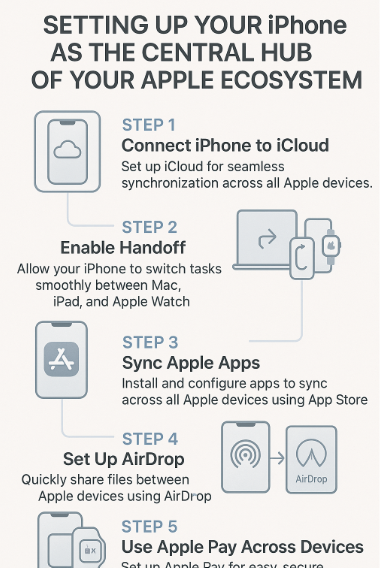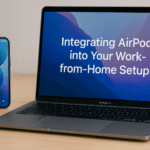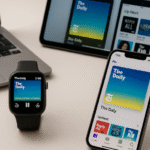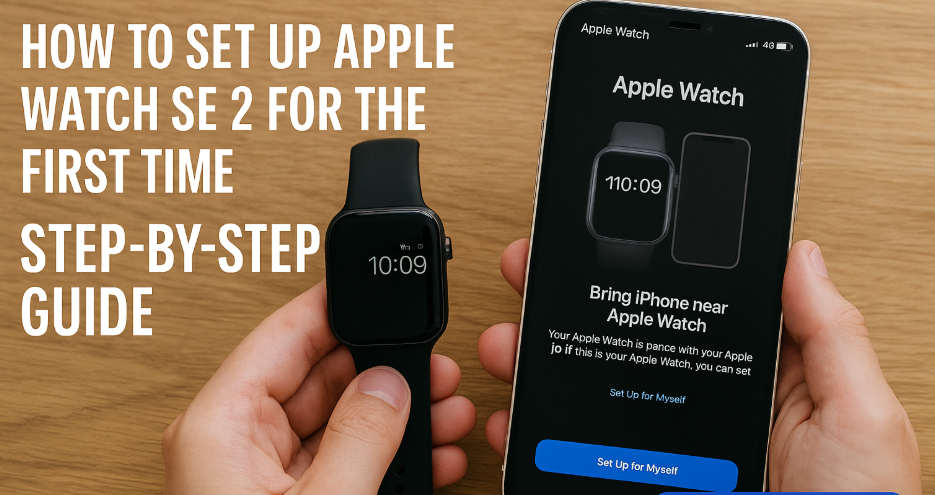In the ever-evolving world of technology, setting up your iPhone as the central hub of your Apple ecosystem can significantly improve the way you use your devices, apps, and services. Whether you’re managing your calendar, syncing photos, or making payments, your iPhone can seamlessly interact with your other Apple devices to create an interconnected experience. Let’s explore how you can leverage your iPhone to its fullest potential and ensure that it becomes the heart of your Apple ecosystem.
Pillars of the Apple Ecosystem: The Importance of Centralization
Before we dive into setting up your iPhone, it’s important to understand what an ecosystem is in the context of Apple. Apple’s ecosystem refers to its interconnected suite of devices iPhone, MacBook, Apple Watch, iPad, and services like iCloud, Apple Music, and Apple TV+. By integrating these devices and services, you can ensure smooth synchronization and continuity, making your workflow more efficient.
To make your iPhone the center of your ecosystem, it must serve as the starting point for syncing data, managing apps, and controlling settings across all devices. For more insights into how the Apple Watch fits into this ecosystem, check out this detailed Apple Watch SE 2nd Gen review.
1. Setting Up iCloud: The Backbone of Your Apple Ecosystem
The first step in turning your iPhone into the central hub of your ecosystem is setting up iCloud. iCloud is Apple’s cloud storage service that keeps your data in sync across all your devices. Here’s how to set it up:
- Step 1: Go to Settings > [your name] > iCloud.
- Step 2: Sign in with your Apple ID.
- Step 3: Toggle the services you want to sync, such as Photos, Contacts, Calendars, iCloud Drive, etc.
Once iCloud is set up, your contacts, photos, files, and other data will automatically sync across your devices, ensuring you always have the most up-to-date information at your fingertips.
2. Enable Handoff for Seamless Device Switching
Apple’s Handoff feature allows you to start a task on one device and pick it up seamlessly on another. For example, if you start writing an email on your iPhone, you can pick up right where you left off on your MacBook or iPad. Here’s how to enable Handoff:
- Step 1: On your iPhone, go to Settings > General > AirPlay & Handoff.
- Step 2: Toggle Handoff to On.
- Step 3: Ensure Handoff is enabled on your other Apple devices as well (Mac, iPad, Apple Watch).
This setup ensures that your iPhone becomes the core around which other devices can switch tasks smoothly, creating a fluid user experience.
3. Syncing Apps Across Your Devices
Another key feature of your iPhone as the central hub is app synchronization. Apps installed on your iPhone can be automatically synced with other Apple devices, ensuring that you have the same apps, preferences, and settings across all platforms.
- Step 1: On your iPhone, go to Settings > [your name] > iTunes & App Store.
- Step 2: Toggle Apps to sync automatically.
- Step 3: For apps like Notes, Reminders, and Safari, ensure they are enabled under iCloud settings for syncing.
This ensures that whether you’re using your MacBook, iPad, or Apple Watch, the same apps with the same data are readily available at all times.

4. Master AirDrop for Instant File Sharing
AirDrop allows you to share files between Apple devices with ease. Whether it’s a photo, document, or webpage, AirDrop offers a fast and simple way to move files between your iPhone and other Apple devices.
- Step 1: On your iPhone, swipe down from the top-right corner to open Control Center.
- Step 2: Tap on AirDrop and choose either Contacts Only or Everyone.
- Step 3: On the device you wish to send files to, select AirDrop and choose the file to share.
This feature ensures that your iPhone remains the centerpiece of your file-sharing needs across all devices in the Apple ecosystem.
5. Apple Pay: Unifying Payments Across Devices
Apple Pay allows you to make secure payments with your iPhone and Apple Watch. Whether you’re shopping online or in-store, Apple Pay simplifies transactions by syncing your payment methods across all your Apple devices.
- Step 1: Go to Settings > Wallet & Apple Pay on your iPhone.
- Step 2: Add your credit/debit card to Apple Pay.
- Step 3: Enable Apple Pay on your Apple Watch for tap-to-pay convenience.
With Apple Pay, your iPhone is now central to your entire payment process, making shopping more efficient and secure.
6. Enjoying Apple Music and Other Services
Your iPhone is the ideal hub for all your Apple services. Whether it’s Apple Music, Apple TV+, or Apple Arcade, the iPhone provides easy access to all content from any device in your Apple ecosystem.
- Step 1: Download the relevant apps from the App Store.
- Step 2: Sign in with your Apple ID to sync your services across all devices.
Now, you can start a playlist on your iPhone and continue it on your MacBook, or enjoy movies on your iPhone that are seamlessly synced to your Apple TV.
Conclusion: Your iPhone as the Central Hub
Setting up your iPhone as the center of your Apple ecosystem is a straightforward process that will enhance the way you interact with all of your devices. By integrating iCloud, enabling Handoff, syncing apps, using AirDrop, and setting up Apple Pay, you will create a unified ecosystem that maximizes productivity and streamlines everyday tasks.
For more ways to integrate your Apple devices, check out these helpful guides:
- Guide to Mac and Apple Watch Password-Free Authentication (2025 Edition)
- How to Automatically Switch AirPods Between Mac, iPhone, and Watch
- How to Effortlessly Move App Data Between Mac and iPhone
- How to Manage Mac Photos Across the Entire Apple Ecosystem
- How to Seamlessly Integrate AirPods into Your Work-from-Home Setup







